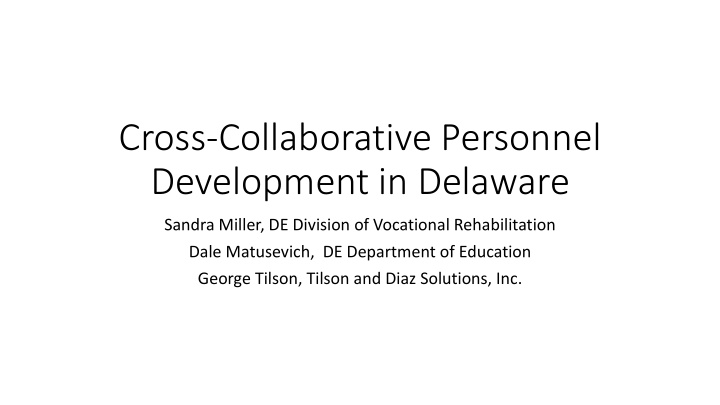



Cross-Collaborative Personnel Development in Delaware Sandra Miller, DE Division of Vocational Rehabilitation Dale Matusevich, DE Department of Education George Tilson, Tilson and Diaz Solutions, Inc.
Purpose of our session • Provide Overview of Delaware’s Transition Collaboration model, reflecting NTACT priorities • Describe key components of the model • Statewide Transition Cadre • Youth Leadership Initiative • Career and Technical Education/Transition Pathway • Cross-Agency Professional Development • Facilitate participant discussion of Lessons Learned; implications for expansion and replication
Context: Delaware’s Logic Model for Transition Reflecting Evidence-Based and Promising Practices • All education is related to career development • Mandated by age 14-16; really begins in early childhood • Reflects self-determination, person-centered approach, high expectations of all stakeholders, importance of champions, and cross- agency collaboration • Transition enables access to opportunities afforded to ALL children and youth
Key Component: Delaware Statewide Transition Cadre • Implemented in 2013 • Majority of LEAs, Charters, and Partners • Cross-agency; cross-role participation • Monthly all-day meetings, with professional development • Opportunity for team review of data, planning, and shared TA
Key Component: Youth Leadership Initiative • Established Fall 2015; 3 statewide meetings annually; active engagement in State Transition Conference • 70 youth participants, reflecting diversity of talents and support needs; geographic regions • Engaged in discussions of their educational and transition-related experiences; identified success stories as well as challenges; recommended strategies for improving experiences for all youth • Focused on their future aspirations; emphasized desire for high expectations and opportunities to learn and use their self-advocacy skills
Key Component: CTE/Transition Pathway Initiative • Beginning in middle school, with emphasis on self-determination and career exploration – 4-course sequence • Increase participation and successful completion of CTE courses, reflecting students’ interests • Expand training/supports/coaching to CTE teachers around effective learning strategies and accommodations • Provide extensive opportunities for authentic work-based learning • Involve youth in dual-enrollment and articulated programs with IHE, leading to industry certifications and employment in high growth career fields
Key Component: Cross-Agency Professional Development • Dept. of Education, Division of Vocational Rehabilitation, Division of Developmental Disability Services • Natural outgrowth of joint ventures to serve transitioning youth, recognizing the value of common methods for assessment/discovery, planning, and coordinated activities • Ongoing input from cadre members and youth leaders • Intensive 3- day: “Developing Authentic Customized WBL and Jobs for Individuals with Disabilities” • Led to the development of a shared assessment tool (Life and Career Assessment Matrix)
The Life and Career Assessment Matrix 1. My Community 2. My Interests 3. My Talents 4. My Positive Personal Attributes 5. My Career Preparation 6. My Career Aspirations 7. My Life Aspirations 8. My Challenges and Solutions 9. My Ideas 10. My Action Plan
9
Open Discussion
Recommend
More recommend